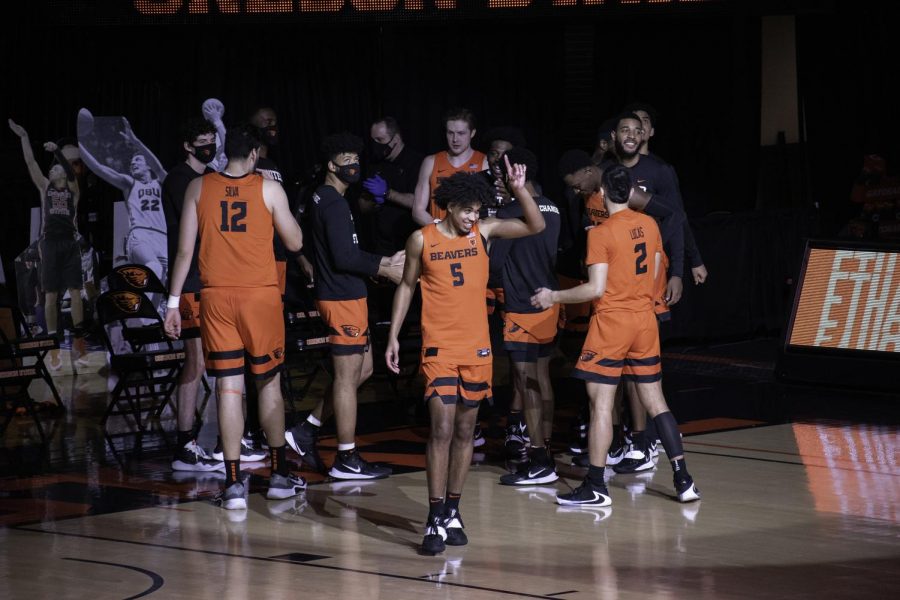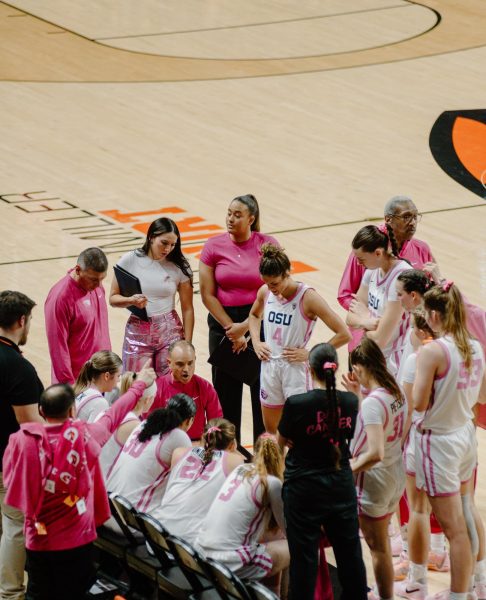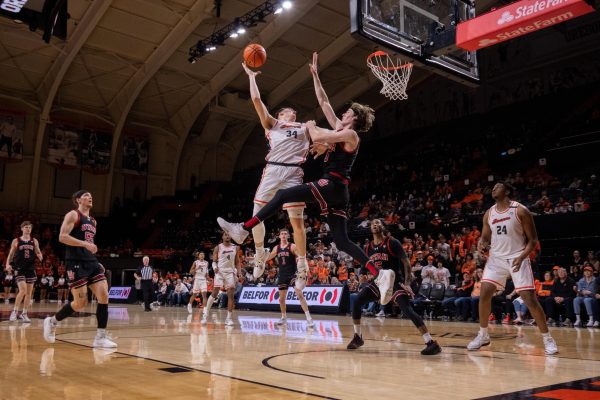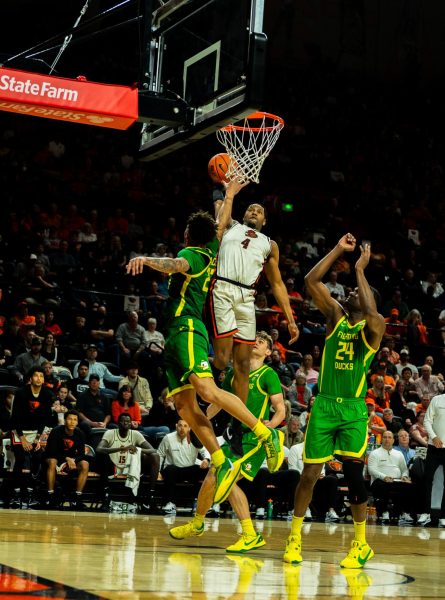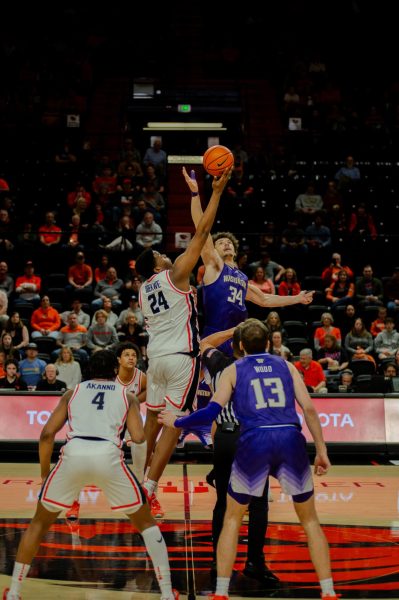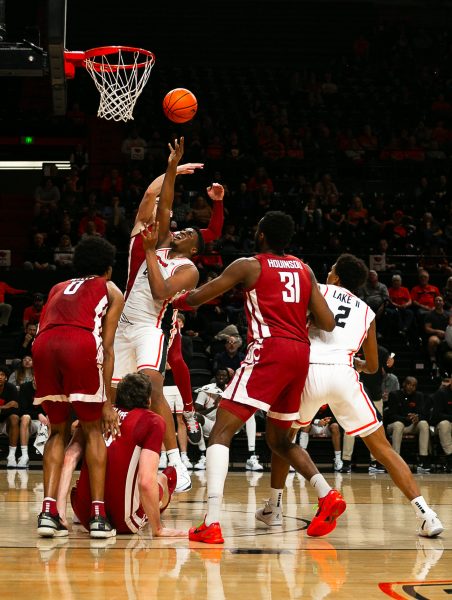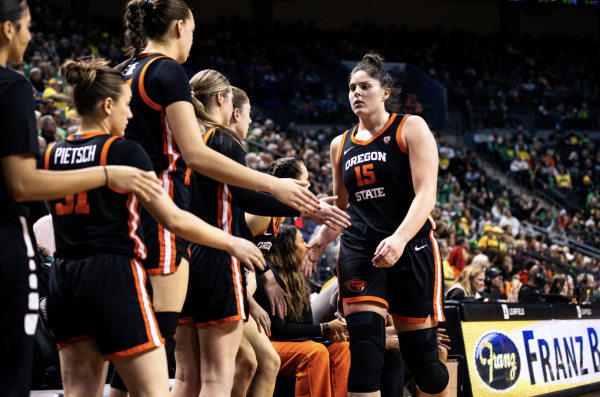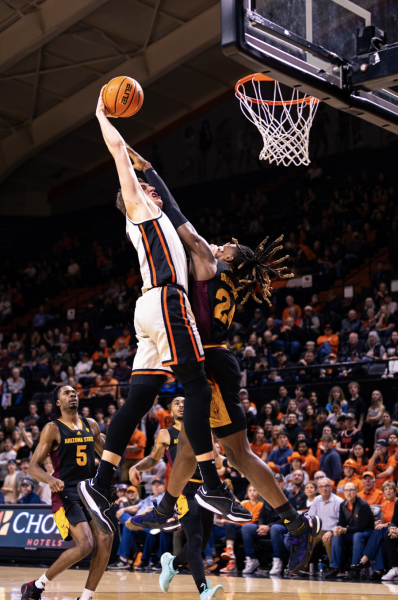What will the Elite Eight Run mean for Oregon State’s future, on and off the court?
April 15, 2021
The Oregon State Beavers are fresh off of an unprecedented March Madness run, stealing a bid by winning the PAC-12 and running with it until the Elite Eight. But now that the dust has settled, what’s next?
Big sporting achievements on bigger stages tend to have a lot of consequences afterward, especially true for those achievements that grab headlines and create engaging narratives, such as the Beavers’ run from being predicted to finish last in the PAC-12 to being one of the last eight teams standing in the nation.
It’s nearly impossible to know exactly what will happen to Oregon State after this, both the team and the school, but a few of the early effects stemming from that amazing month of basketball have already started to take shape.
The men’s basketball team had been in a rut for the past 40 seasons before this run. The team had not won an NCAA Tournament game since the 1981-82 season and had only made one other NCAA Tournament appearance since 1991. With what might be the best opportunity to start a streak of sustained success in 40 years, how will the team try to capitalize on this opportunity?
The first domino has already fallen, as Head Coach Wayne Tinkle was signed to an extension until the 2026-27 season just a week after the Beavers’ season came to a close with a loss to the Houston Cougars. The hope seems to be that this March run was Tinkle’s breakthrough, as he has been with Oregon State since 2014 but has been close to .500 in his time with the Beavers, with a 113-109 record over seven seasons, and a losing PAC-12 record of 52-76.
Yet, the Elite Eight run the team went on was further than what the school achieved with NBA Hall of Famer Gary Payton on the team in the late 1980s, where the team lost in the first round for three consecutive years. So how will Tinkle go about continuing this success? First off, the coach hopes that recruiting to the program will be easier.
“[This run] certainly will allow us to get in the race with more recruits, whether it be high school, junior college, or out of the transfer portal,” Tinkle said over email. “It also strengthens our message in how we present our culture and player development. Being able to engage in conversation about our experience competing to reach the Final Four and striving to get over that hump to reach the national championship is not something every program can talk about, so that is something that is certainly intriguing to players on the recruiting trail.”
The recruiting classes from 2017 to 2020, the classes which made up the Elite Eight team, never ranked above 40th nationally or higher than 9th in the PAC-12. The best recruit in any of those classes was Ethan Thompson Jr., the son of assistant coach Stephen Thompson, Yet, despite the comparative lack of success on the recruiting trail, the team still managed to go as far as the final eight teams in March.
Tinkle said that he hopes the postseason success of this year will help in the transfer portal, which has become increasingly important in college sports. In the 2020 offseason, for the first time ever, over 1,000 players entered the transfer portal looking to transfer to another school and play for their team. In 2021, that number is nearly 1,300 already. Players now tend to get immediate eligibility from the NCAA after transferring, making the process more appealing than before when they had to sit out for a year.
Transfers are increasingly impacting the sport in a big way, as teams can now look to fill holes immediately instead of having to wait for a freshman recruit to develop over the years. The 2020 Beavers, for example, had significant contributions and an injection of much-needed athleticism and rebounding from junior forward Warith Alatishe, who used the transfer portal to come to Corvallis from Nicholls State and averaged 8.6 rebounds per game in his first year with the Beavers, a team-high by nearly double the next highest player.
Additionally, junior forward Maurice Calloo and junior guard Tariq Silver both played at other D1 schools before going to a junior college school and then transferring to Oregon State. Senior center Roman Silva came from a junior college school as well. All played significant minutes in March.
Transfers were important to Oregon State’s success in 2021, and the increased visibility from their postseason success this year could serve to make more players consider going to Oregon State. The extra infusion of talent on the team could be the boost the Beavers need to replicate their 2021 success, and the process has already started.
2019’s 60th overall recruit Chol Marial, a towering 7’2” center formerly of the Maryland Terrapins, announced his commitment to the Beavers on April 14.
Yet, no matter how many great players Oregon State is able to convince to come play in Corvallis, they still need to be coached well to replicate the success of the 2020-21 team. Luckily, Tinkle believes he has learned from the team’s successful stretch of games to finish the season after a rough start and hopes to continue that going forward as well.
“The adjustments we made were to simplify our approach, and that happened earlier in the year after our loss at home to Arizona in mid-January,” Tinkle said. “We made some minor adjustments schematically, but really simplified the approach and knew that, in time, if we stayed consistent we would find success. We didn’t know how many wins and losses that would result in, but we knew we would play good team basketball on both sides of the floor. We stayed consistent with the adjustments and our message and will certainly look to carry those things forward.”
But Tinkle does not want tactics and game plans to be the only thing the players and coaches take from this tournament run going forward. The coach also wants it to help them as people, on and off the court.
“The things that we stand for really led to our success. We have such high character young men in the program that we expect to continue moving the needle in the right direction,” Tinkle said. “With them experiencing that level of success doing it the Beaver way, it is something they can lean on to give them confidence, not only in future years in our program, but as they become husbands, fathers and highly productive members of society.”
An Elite Eight run could have big impacts on the future of the team, but what about outside the team?
First of all, there’s the perception of the Beavers in the media and coaching circles. Oregon State finished ranked 20th in the final coaches poll of the season, the first time they were ranked at all in over 30 years.
The increased media respect actually extends not only to Oregon State, but to the PAC-12 as a whole. The PAC-12 had five teams make the tournament, all of whom won their first-round game, four of which went into the Sweet Sixteen, three into the Elite Eight and one in the Final Four. From the Sweet Sixteen to the Final Four, they had or were tied for the most teams of any conference still in the tournament. All of this despite the highest seeded team being the number five seed Colorado, who went out in the Round of 32.
Tinkle says that he expects this success from the team and conference as a whole to have a positive impact on rankings and seeding going forward.
“This has been a great league for years, [and] I think the success we had in March should allow us to have some more exposure during the season so the entire country can see what great basketball is being played on the west coast,” Tinkle said. “Hopefully that leads to improved seeding in the tournament and future years like this past one. I think the tougher the league becomes, the more it prepares all of us to have success in March.”
Outside of improved seeding and visibility, Tinkle never thought twice about what the media thought of the team; he’s much more concerned with how the fans see the team.
“[The outsider’s view of the team] isn’t something we really concern ourselves with,” Tinkle said. “It is really out of our control and doesn’t have much bearing on what matters, we proved that this past season. Outside of the players and staff, Beaver Nation is who we really are concerned with viewing us in high regard. They have been in our corner and supported us through ups and downs. Making them proud of what we are accomplishing on the court, in the classroom and in the community is a huge part of what drives us.”
So how has Beaver Nation reacted to the team’s unprecedented run?
First off, there is social media.. The number of views on tweets by @BeaverAthletics went up by 912%. For @BeaverMBB during the tournament run, tweet views increased by a an even higher 1,243%. The men’s basketball account also increased its follower count by 10%.
On Instagram, the follower count for the men’s basketball account went up by 25% and they registered 1.35 million impressions, or views, over the month of March. That’s the first time the account ever recorded over 1 million impressions in a month.
Overall, across Twitter, Instagram, and Facebook, the social media accounts for Oregon State Men’s Basketball and general athletics had over 24 million impressions.
Additionally, there were eight thousand clicks on merchandise links. And according to Erik Anderson, the merchandise manager at the Beaver Store, the shop saw an increase in sales in and after March.
“One of the things that makes pulling exact data from this basketball run so challenging is that we were closed last year at this time, so I’m having to base our comps on 2019 sales levels,” Anderson said over email. “That said, sales for the last three or four weeks have been trending above 2019 sales levels, which is no doubt attributed to basketball.”
This was no surprise to John Valva, Executive Director and Vice President of Alumni Engagement for Oregon State’s Alumni Association. He said that engagement tends to go up after big athletic achievements, and compared this 2021 March Madness run to other great Oregon State athletics events such as the baseball national title runs of 2005, 2006, and 2018, the Fiesta Bowl championship from the 2000 season, and the 2016 Women’s Basketball Final Four run. He explained that events like this are always bound to make alumni proud.
“Athletics brings pride and notoriety to OSU alumni,” Valva said over email. “When our student-athletes succeed publicly on a national stage like we just experienced, we see it in the eyes of our alumni, hear in their crackling voices, and ultimately in their participation and engagement. I have never met an OSU alum who presumes athletics excellence, but almost every graduate I know loves OSU. So when we excel publicly, we especially relish it.”
The impact on Oregon State alumni could potentially be matched by future students as well. According to Bloomberg, impressive March Madness runs are almost always followed by increased applications. In recent years, memorable March underdogs such as Florida Gulf Coast University, a 15-seed that made the Sweet Sixteen in 2013, and Wichita State, who unexpectedly made the Final Four that same year, saw applications to their school increase 27.5 and 30 percent respectively.
This strong correlation between sports success and academic applications is known as the Flutie Effect, named after Doug Flutie, who threw a famous Hail Mary for Boston College in 1984 which led to increased applications for the school.
The effect of all this down the line is impossible to predict, but the expectation from the athletics team is that it will lead to continued success for the team and more fans in the stands going forward. At least, that’s what Wayne Tinkle hopes for.
“It provides a great opportunity to reinforce and build on the culture we have established here,” Tinkle said. “We have accomplished great things on and off the court in large part from consistent messages and values and with this run, it makes it much easier for incoming members of the program to buy into those values and also strengthens them within all of the members returning. It also builds great excitement for potential recruits and all of Beaver Nation heading into next season which should create a great atmosphere in Gill Coliseum.”












































































































